This month’s Bay Island Bonsai meeting featured a critique by Akio Kondo. Members brought the trees and Kondo provided guidance about topics ranging from care, to styling to display. Here are some highlights from the event.
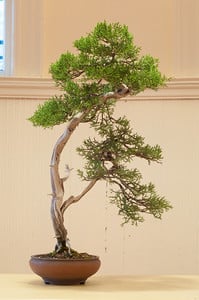
Western juniper
Kondo appreciated the thinness of the two trunks, and liked that the shorter trunk was thinner than the longer one. He found the foliage a bit dense at the top of the tree, but nothing that minor cutback couldn’t address. He liked the size and shape of the pot, but recommended a higher quality container for exhibits.
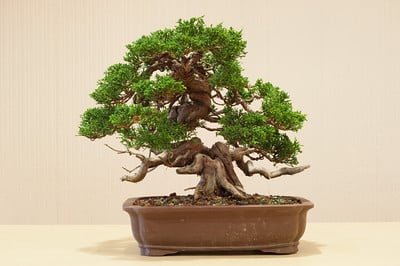
Shimpaku
Kondo’s first comment about the shimpaku above was that it has a lot of branches. Typically, he said, collected trees don’t have many branches, and greater numbers of branches are more characteristic of younger trees. He then suggested that a small branch growing from the inside of a curve in the trunk be removed. With a few exceptions, he found the branches to be thin relative to the trunk – a much easier problem to solve than its opposite: branches that are too thick. He suggested a slightly smaller pot in a similar style would be a good fit for the tree.
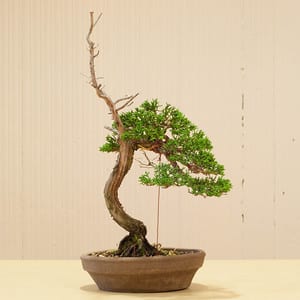
Shimpaku
Kondo had less to say about the small shimpaku above as he had just finished wiring it. He suggested opening up the shari a bit and then he and Boon considered shortening the jin. Boon held a piece of paper infront of portions of the jin so we could get a better idea of what the tree would look like with varying amounts of jin.
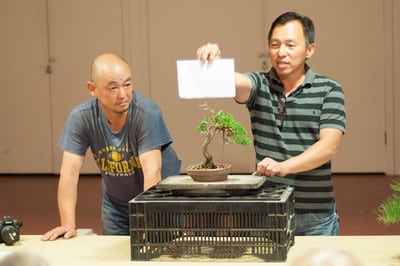
Pondering jin length
Kondo peeked inside the foliage of the black pine below and noted and 5 branches emerged from the same spot near the top of the trunk. He suggested removing 1 or 2 of these. His recommendation for a pot: oval, thinner and slightly smaller.
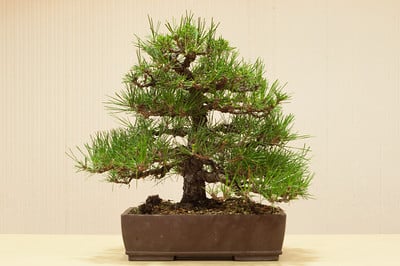
Black pine
Many of us were happy to see a refined bougainvillea in the critique – Kondo so much so that he offered to buy the tree and bring it back to Japan. He suggested removing one of the four branches that emerged from a congested section of the trunk, and pointed out another branch that could be removed and replaced by the branch above it. Although we encouraged him to cut these branches on the spot, Kondo demurred with a smile and left this to the tree’s owner. He found the pot size and color to be appropriate.
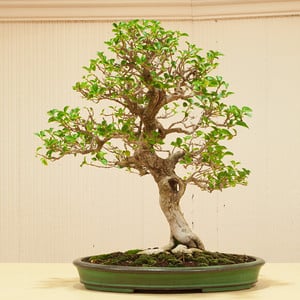
Bougainvillea
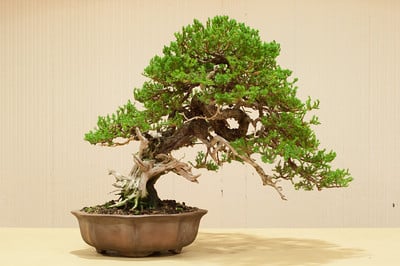
Procumbens juniper
Kondo immediately praised the procumbens juniper above for conveying great age. He suggested opening additional shari along the trunk – not near the apex, but along the middle section of the trunk. He had two suggestions for the pot – same size and shape but a tiny bit smaller, or maybe a dark nanban.
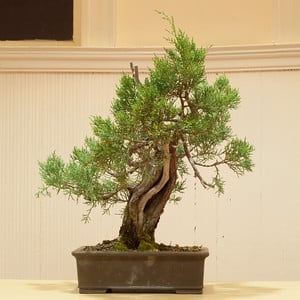
Sierra juniper
Kondo placed a 2 x 4 on edge under the right side of this Sierra juniper because he liked the trunk line moving slightly to the left. When asked if he thought the tree would point to the left or the right, he suggested that either direction could work.
Kondo also had comments for a few of my trees. He started with my Korean hornbeam.
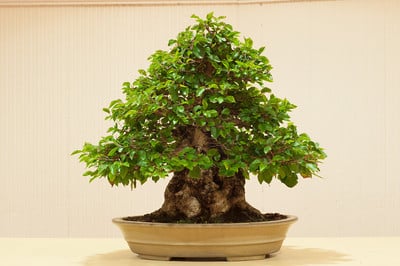
Korean hornbeam
Pot – too small. Kondo thought a deeper oval in blue or “white” – white being the term Japanese use to describe antique pots that were once white but are now quite darker – would be appropriate. Health – weak. Weak? Kondo intimated that similar trees in Japan are much more vigorous. Mine’s off a bit as it’s recovering from summer defoliation. Kondo then mentioned potting advice I hadn’t heard before. He suggested repotting the tree every other year – a bit more than I’m used to as the roots tend to develop slowly – and completely bare-rooting it every 10 years. The idea is that giving hornbeam a little push and lots of fresh soil maintains vigor over time.
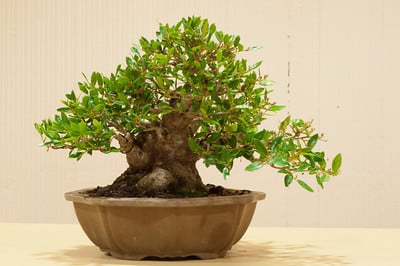
Yaupon holly
I didn’t see Kondo’s comment about my holly coming at all. He thought the shape and style was fine, but recommended grafting all new branches – from a female specimen. Male trees commonly develop thick trunks but no fruit, whereas female plants offer great fruit but rarely develop thick trunks. It’s an interesting suggestion – I’m now on the lookout for female ilex vomitoria.
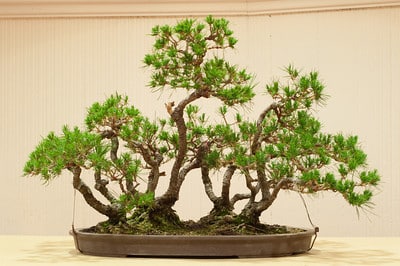
Red pine forest
“Omoshiroi,” Kondo said. Same thing his kohai, or junior apprentice, Daisaku Nomoto said when he saw the tree last winter. Kondo didn’t have any suggestions for the branches, noting that the tree has more of a Chinese character than a Japanese character. He thought a narrow, but very long pot would make an interesting choice. He especially wanted to see space under the long branches on the right side of the tree. His second suggestion was planting the grove on a long slab. I’m now on the lookout for one of those too.
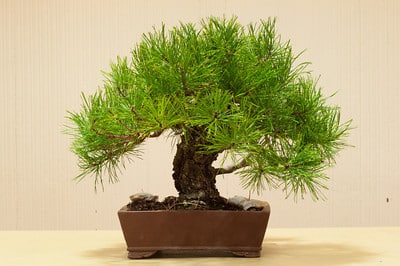
Shore pine
My shore pine proved more difficult for Kondo. He found the needle size to be too big for the size of the tree. If the tree were another eight inches taller, the ratio would be alright. As it is, I’ll have to see what I can do to reduce the needle size. Training shore pine is like training white pine, so I’ll go easy on the water and fertilizer and see what happens.
Subscribe to Bonsai Tonight
New Posts Delivered Every Tuesday and Friday
Joey McCoy says
Great post about the critique! Dwarf yaupon holly (the common hedging plant with many cultivar names) are all cloned males. The female ones are all larger specimen sized (Pride of Houston, etc) or the native stock which is a small tree. Yaupons graft well, but the only way you’d get berries is to go with one of the larger varieties which have bigger leaves and longer internodes. I’d stick with it being male and enjoy the flowers, it’s already a fantastic bonsai!
Jonas Dupuich says
Thanks so much for the holly info Joey, I really appreciate it. I’m now curious to see the various female holly, less for grafting purposes than for curiosity’s sake.
Cheers,
Jonas
Joey McCoy says
They’re all around this part of the world (Austin, Tx) and eastward. ‘Pride of Houston’ was developed specifically for the abundance of red berries and is probably the most full looking. The wild variety usually has sparse berries near the ends of branches. Birds love them! There are also orange and yellow berry cultivars, wine colored new leaves (‘Bordeaux’) and even a weeping variety seen in nurseries occationally. The newest one I’ve seen is a tiny leafed variety (maybe 1/3 the size of dwarf yaupon leaves) called ‘Gremicr’ or Micron. I love this species.. one of the best for Bonsai!
Fred Janson says
Very nice critique
japanesepots says
Nice post as usual, Jonas. Akio Sans pot choices to me, were spot on! Really love that procumbens….but I’d really really love it with Shimpaku foliage! LOL.
tmmason10 says
Nice post Jonas. That’s interesting that he thought the hornbeam was weak, looks good to me. Your trees are looking great.
Marty says
Nice post. I particularly liked the comments on the Korean Hornbeam as a follow on to your post about defoliating. I have one that I just can’t get to ramify very well and I think that a slightly larger pot will allow me to defoliate and start to make serious progress.